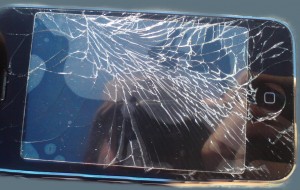Mobile devices do not exist
I would argue that the design of almost all mobile devices is such that they arguably are not meant to be used whilst actually mobile. Instead, they are actually devices which whilst they offer a large amount of portability, are not designed to be actively used while moving.
Stop to interact design
The vast majority of mobile systems are essentially designed around the concept of stop to interact. They are mobile in that they are portable, but in order to actively interact with a system, the user must stop moving, look down at it, interact with the device, and then get going again. Some systems, for example music players, and navigation systems, at least output to the user in between these stops, but they still mostly follow the same stop to interact design.
The reality of mobile device use

- Social issues such as ‘pavement rage’ when people are too busy looking at their phone to pay attention to others they are sharing space with.
- Physical issues when people walk without looking, such as tripping over, or walking into the road
- Driver distraction by mobile device use, which can cause people to crash their cars.
- Software issues when people press the wrong thing, such as sending messages by accident.
- Dropped and broken devices.
But what about speech recognition, customised buttons (etc)?
Existing workarounds, such as voice recognition and action specific buttons (eg. headset ‘answer call’ buttons, music buttons), allow a certain amount of control of systems, but are limited in their application or success so far. Speech recognition in particular appears to offer an awful lot of promise (and has been about to become mainstream since approximately 1995); however, even that is somewhat limited when moving - microphones have to be well placed to catch the sound, whilst not exposed to excessive noise from surroundings, the wind, or whatever equipment is being used by the person in their movement activity.
Related themes:
Interaction in Motion,